Abstract
Using the java applet, which encounters all the possibilities of the evolution of finches on two islands, the research on the issue of possible evolution directions for the periods of 100, 200, and 300 years will be held.
Introduction
The main aim of the laboratory work is to define in what measure the Beak Size, and its suitability to the Precipitation influences the population of finches on two mutually independent and isolated islands.
Method
It is known, that the Beak Size changes dependently on the share of soft and hard seeds included in the nutrition system of the birds. The deeper and wider beak better suits for cracking hard seeds. Prolonged and smaller beaks better suits for cracking soft seeds. Thus, if the Beak Size of a bird does not suit the main part of the seeds, this bird dies early.
Results and conclusions of the researches
The Influence of Precipitation on Beak Size and Population Number
The Beak Size directly influences the population of the finches, as the initial circumstances, set for both islands include the prevalence of hard seeds over soft seeds, and as the bigger beak mostly suits for breaking hard seeds, the population of the finches with bigger beaks will grow (Wallace island).
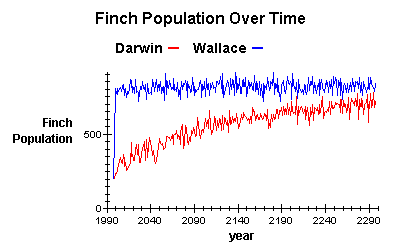
As it can be seen on the histogram, the population of Darwin Island will also steadily grow, but this is caused by the growth of the beak through the times.
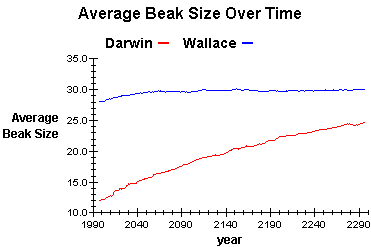
Thus, it must be emphasized, that the finches with bigger beaks have better chances to survive, as the hard seeds prevail on the islands. The hypothesis is supported by the appeared data, and the graphs given above prove that.
The survival histogram shows that the amount of the survived birds changed proportionally to the total population, but the higher survival percentage have the groups with the average Beak Size, comparatively to the Beak Size of the whole population.
The changes in the length of the experiment show the same tendency: birds with bigger beaks grow in population, and the birds with small beaks increase their size, and as the size grows, as does the population.
The changes of the initial precipitation conditions lead to the following changes in the outcomes of the experiment: The population of the Darwin Island (where the percentage of the soft seeds had been extremely increased) tends to grow extremely through the first thirty years.
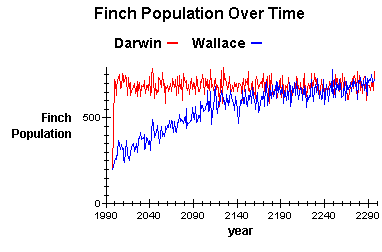
The Beak Size grows only on the island, where hard seeds prevail.
Precipitation and the beak size are directly connected, as has been shown in one of the previous outlines. The held experiment shows, that the Beak size on Darwin Island had been steadily increasing, as the dry climate leads to the growth of the plants with hard seeds.
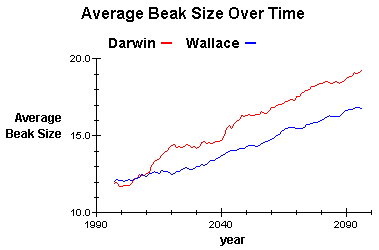
As for the population, it is necessary to mention, that in the first period it seriously decreases. Then, the survived generations start adapting to the nutrition system by growing the beak, and the population starts increasing.

The comparison of the evolution on the two islands is base on the following data on the Beak Size.
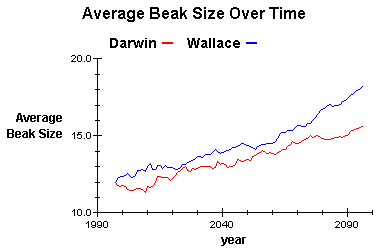
The population
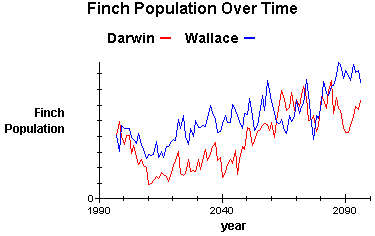
At first, it may seem that the initial conditions are equal, but it is necessary to mention, that the various factors differ. The observed differences of the outcomes with definitely equal initial conditions are just the result of random nature. The longer experiments (for 200 and 300 years) show absolute equality in the changes of both researched factors.
The extreme increase of the precipitation leads to the rapid growth of the Beak, while the default conditions tend to lead to a slight recession.

The case of the opposite initial conditions relating to the precipitation shows, that the finches on the island with the decreased one tend to have bigger Beaks at the end of the experiment, but the population tends to be bigger. The suggestion may be, that hard seeds are more nutritious.
Natural selection
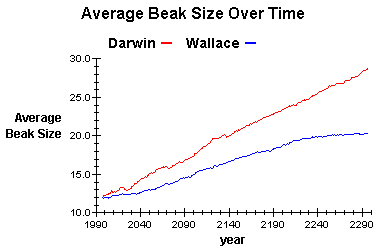
The model here is stabilization, as it relates only to finches with differing characteristics. As it is shown on the graphs, the birds with small Beaks tend to decrease the population and vice versa.
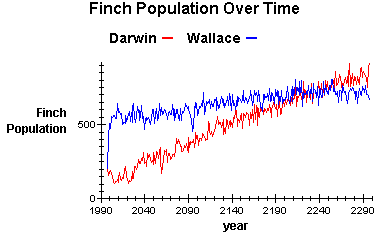
The average Beak size of the earliest generation on Darwin Island is 12.69 mm and of the latest is 26.61mm.
The data relating to the Wallace Island comprise 12.05mm and 20.1mm relatively.
The population differences are caused by the different conditions of living. Thus, as has been mentioned earlier, the finches on Darwin Island are just not perfectly adapted to the conditions in the difference with the finches of the Wallace Island.
Effect of Island Size
The obvious hypothesis is that the increase of the living territory will cause the increase of food availability, which has to provide better surviving, which will lead to the increase of the population. Whether it is so, we need to make the observation
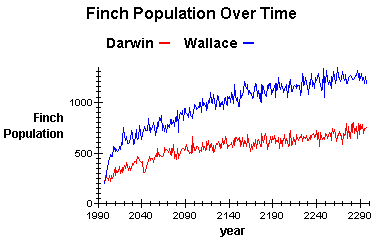
Here we can see the changes in the population amount. (The size of the Wallace Island had been enlarged in the initial conditions).
As for the Beak size, there is absolutely no difference, as the change of the sizes of the island in no way leads to the changes of the nutrition system. The results are quite expected, as the changes in the sizes can not cause the Precipitation changes.
To prevent the population changes the following: the Precipitation, the cluster size, the variability. These are the main factors that influence the population changes. There is no need to make additional tests, as enough experiments have been held and regarded, relating the issue of the population changes